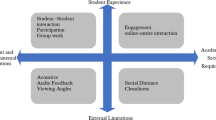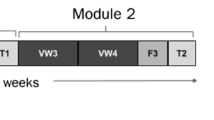Abstract
Due to the COVID-19 pandemic, face-to-face teaching has all but disappeared, with many higher education institutions adopting blended and online learning. The case study described in this chapter explored the experience of nine instructors at an English-medium university in Hong Kong who used HyFlex, a blended-learning model, to teach English for Academic Purposes. Overall, the teachers were unprepared to use this pedagogical approach to teach concurrent classrooms as required. However, they identified several strategies that facilitated teaching and learning in the HyFlex mode: utilising student response tools, incorporating station rotation and focusing on pairs or smaller groups of students. These techniques could be used to improve the delivery of blended learning in higher education.
Access this chapter
Tax calculation will be finalised at checkout
Purchases are for personal use only
Similar content being viewed by others
References
Adedoyin, O. B., & Soykan, E. (2020). Covid-19 pandemic and online learning: The challenges and opportunities. Interactive Learning Environments. https://doi.org/10.1080/10494820.2020.1813180.
Albion, P. R., Tondeur, J., Forkosh-Baruch, A., & Peeraer, J. (2015). Teachers’ professional development for ICT integration: Towards a reciprocal relationship between research and practice. Education and Information Technologies, 20(4), 655–673. https://doi.org/10.1007/s10639-015-9401-9
Amhag, L., Hellström, L., & Stigmar, M. (2019). Teacher educators’ use of digital tools and needs for digital competence in higher education. Journal of Digital Learning in Teacher Education, 35(4), 203–220.
Asarta, C. J., & Schmidt, J. R. (2020). The effects of online and blended experience on outcome in a blended learning environment. The Internet and Higher Education, 44. https://doi.org/10.1016/j.iheduc.2019.100708.
Beatty, B. (2006, October). Designing the HyFlex world - hybrid, flexible courses for all students. Paper presented at Association for Educational Communication and Technology International Conference, Dallas, TX.
Beatty, B. (2007). Transitioning to an online world: Using HyFlex courses to bridge the gap. In C. Montgomerie & J. Seale (Eds.), EdMedia: World conference on educational media and technology (pp. 2701–2706). Association for the Advancement of Computing in Education (AACE).
Beatty, B. (2010). Hybrid courses with flexible participation – the HyFlex design. Retrieved from http://itec.sfsu.edu/hyflex/hyflex_course_design_theory_2.2.pdf
Beatty, B. (2014). Hybrid courses with flexible participation: The HyFlex course design. In L. Kyei-Blankson & E. Ntuli (Eds.), Practical applications and experiences in K-20 blended learning environments (pp. 153–177). IGI Global.
Betty, B. J. (2021). Hybrid-flexible course design: Implementing student-directed hybrid classes. EdTech Books. Retrieved from https://edtechbooks.org/hyflex
Boelens, R., Laer, S. V., Wever, B. D., & Elen. J. (2015). Blended learning in adult education: Towards a definition of blended learning. Retrieved from http://www.iwt-alo.be/wpcontent/uploads/2015/08/01-Project-report-Blended-learning-in-adult-education-towards-adefinition-of-blended-learning.pdf
Braun, V., & Clarke, V. (2006). Using thematic analysis in psychology. Qualitative Research in Psychology, 3(2), 77–101. https://doi.org/10.1191/1478088706qp063oa
Cabanatan, P. (2003). Integrating pedagogy and technology: The SEAMEO INNOTECH experience. Paper presented at the experts meeting on Teachers/Facilitators Training in Technology–Pedagogy Integration, Bangkok.
Chappelle, C. A., & Sauro, S. (2017). The handbook of technology and second language teaching and learning. Wiley-Blackwell.
Cheng, G., & Chau, J. (2016). Exploring the relationships between learning styles, online participation, learning achievement and course satisfaction: An empirical study of a blended learning course. British Journal of Educational Technology, 47(2), 257–278.
Creswell, J. W. (2008). Educational research: Planning, conducting, and evaluating quantitative and qualitative research (3rd ed.). Pearson Education, Inc..
Davies, J. A., Davies, L. J., Conlon, B., Emerson, J., Hainsworth, H., & McDonough, H. G. (2020). Responding to COVID-19 in EAP contexts: A comparison of courses at four Sino-foreign universities. International Journal of TESOL Studies, 2(2), 32–52.
Dhawan, S. (2020). Online learning: A panacea in the time of COVID-19 crises. Journal of Educational Technology System, 49(1), 5–22.
Dziuban, C., Graham, C. R., Moskal, P. D., Norberg, A., & Sicilia, N. (2018). Blended learning: The new normal and emerging technologies. International Journal of Educational Technology in Higher Education, 15(3). https://doi.org/10.1186/s41239-017-0087-5.
Ertmer, P. A., Ottenbreit-Leftwich, A., & Tondeur, J. (2015). Teacher beliefs and uses of technology to support 21st century teaching and learning. In H. R. Fives & M. Gill (Eds.), International handbook of research on teacher beliefs (pp. 403–418). Routledge – Taylor & Francis.
Fisher, R., Perényi, Á., & Birdthistle, N. (2018). The positive relationship between flipped and blended learning and student engagement, performance and satisfaction. Active Learning in Higher Education. https://doi.org/10.1177/2F1469787418801702
Garrett, N. (2009). Computer-assisted language learning trends and issues revisited: Integrating innovation. Modern Language Journal, 93(s1), 719–740.
Hartshorn, K. J., & McMurry, B. L. (2020). The effects of the COVID-19 pandemic on ESL learners and TESOL practitioners in the United States. International Journal of TESOL Studies, 2(2), 140–157.
Hockly, N., & Dudeney, G. (2018). Current and future digital trends in ELT. RELC Journal, 49(2), 164–178.
Hrastinski, S. (2019). What do we mean by blended learning? TechTrends, 63, 564–569.
Hur, J. W., Shannon, D., & Wolf, S. (2016). An investigation of relationships between internal and external factors affecting technology integration in classrooms. Journal of Digital Learning in Teacher Education, 32(3), 105–114.
Keiper, M. C., White, A., Carlson, C. D., & Lupinek, J. M. (2021). Student perception on the benefit of Flipgrid in a HyFlex learning environment. Journal of Education for Business, 96(6), 343–351. https://doi.org/10.1080/08832323.2020.1832431
Kohnke, L. (2021). GoSoapBox – Encourage participation and interaction in the language classroom. RELC Journal, 52(3), 648–650. https://doi.org/10.1177/2F0033688219872570
Kohnke, L., & Jarvis, A. (2021). Coping with English for academic purposes provision during COVID-19. Sustainability, 13, 8642. https://doi.org/10.3390/su132011520
Kohnke, L., & Moorhouse, B. L. (2020). Facilitating synchronous online learning through zoom. RELC Journal. https://doi.org/10.1177/2F0033688220937235.
Kohnke, L., & Moorhouse, B. L. (2021a). Using Kahoot! To gamify learning in the language classroom. RELC Journal. https://doi.org/10.1177/00336882211040270.
Kohnke, L., & Moorhouse, B. L. (2021b). Adopting HyFlex in higher education in response to COVID-19: Students’ perspectives. Open Learning: The Journal of Open, Distance and e-learning. https://doi.org/10.1177/2F0033688219872570.
Kohnke, L., & Zou, D. (2021). Reflecting on existing English for academic purposes practices: Lessons for the post-COVID classroom. Sustainability, 13, 11520. https://doi.org/10.3390/su132011520
König, J., Jäger-Biela, D., & Glutsch, N. (2020). Adapting to online teaching during covid-19 school closure: Teacher education and teacher competence effects among early career teachers in Germany. European Journal of Teacher Education, 43(3), 608–622. https://doi.org/10.1080/02619768.2020.1809650
Lee, J. C., Walker, A., Belland, B., & Schroder, K. (2019). Understanding willingness to communicate in L2 between Korean and Taiwanese students. Language Teaching Resource. https://doi.org/10.1177/1362168819890825.
Li, L. (2017). New technologies and language learning. Palgrave.
Lowenthal, P. R., Dunlap, J. C., & Snelson, C. (2017). Live synchronous web meetings in asynchronous online courses: Reconceptualizing virtual office hours. Online Learning, 21(4). https://doi.org/10.24059/olj.v21i4.1285.
Merriam, S. B., & Tisdell, E. J. (2016). Qualitative research: A guide to. Design and implementation (4th ed.). Jossey-Bass.
Miller, A. N., Sellnow, D., & Straswer, M. G. (2021). Pandemic pedagogy challenges and opportunities: Instruction communication in remote, HyFlex and BlendFlex courses. Communication Education, 70(2), 202–204. https://doi.org/10.1080/03634523.2020.1857418
Moorhouse, B. L. (2020). Adaptions to a face-to-face initial teacher education course ‘forced’ online due to the COVID-19 pandemic. Journal of Education for Teaching, 46(4), 609–611.
Moorhouse, B. L., & Kohnke, L. (2020). Using Mentimeter to elicit student responses in EAP/ESP classroom. RELC Journal, 51(4), 198–204. https://doi.org/10.1177/2F0033688219890350
Moorhouse, B. L., & Kohnke, L. (2021a). Responses of the English language-teaching community to the COVID-19 pandemic. RELC Journal. https://doi.org/10.1177/2F00336882211053052.
Moorhouse, B. L., & Kohnke, L. (2021b). Thriving or surviving emergency remote teaching necessitated by COVID-19: University teachers’ perspectives. The Asia-Pacific Education Researcher. https://doi.org/10.1007/s40299-021-00567-9.
Moorhouse, B. L., & Wong, K. M. (2021). Blending asynchronous and synchronous digital technologies and instructional approaches to facilitate remote learning. Journals of Computers in Education. https://doi.org/10.1007/s40692-021-00195-8.
Moradimokhles, H. & Hwang, G.-J. (2020). The effect of online vs. blended learning in developing English language skills by nursing students: An experimental study. Interactive Learning Environments. https://doi.org/10.1080/10494820.2020.1739079.
Mouchantaf, M. (2020). The COVID-19 pandemic: Challenges faced and lessons learned regarding distance learning in Lebanese higher education institutions. Theory and Practice in Language Studies, 10(10), 1259–1266. https://doi.org/10.17507/tpls.1010.11
Reicher, S., & Taylor, S. (2005). Similarities and differences between traditions. Psychologist, 18, 547–549.
Romero-Ivanova, C., Shaughnessy, M., Otto, L., Taylor, E., & Watson, E. (2020). Digital practices & applications in a Covid-19 culture. Higher Education Studies, 10(3), 80–87. https://doi.org/10.5539/hes.v10n3p80
Schmidt, S. W., Tschida, C. M., & Hodge, E. M. (2016). How faculty learn to teach online: What administrators need to know. Online Journal of Distance Learning Administration, 19(1), 1–10.
Starkey, L. (2020). A review of research exploring teacher preparation for the digital age. Cambridge Journal of Education, 50(1), 37–56. https://doi.org/10.1080/0305764X.2019.1625867
Tello, S. F. (2008). An analysis of student persistence in online education. In C. Van Slyke (Ed.), Information communication technologies: Concepts, methodologies, tools, and applications (pp. 1163–1178). IGI Global.
Terauchi, H., Noguchi, J., & Tajino, A. (2020). Towards a new paradigm for English language teaching: English for specific purposes in Asia and beyond. Routledge.
Todd, R. W. (2020). Teachers’ perceptions of the shift from the classroom to online teaching. International Journal of TESOL Studies, 2(2), 4–17.
Turnball, D., Chugh, R., & Luck, J. (2021). Transitioning to E-learning during COVID-19 pandemic: How have higher education institutions responded to the challenge? Education and Information Technologies, 26, 6401–6419. https://doi.org/10.1007/s10639-021-10633-w
Van Nuland, S., Mandzuk, D., Tucker-Petrick, K., & Cooper, T. (2020). COVID-10 and its effect on teacher education in Ontario: A complex adaptive systems perspective. Journal of Education for Teaching, 46(4), 442–451.
Watts, L. (2016). Synchronous and asynchronous communication in distance learning: A review of the literature. Quarterly Review of Distance Education, 17(1), 23–32.
Author information
Authors and Affiliations
Corresponding author
Editor information
Editors and Affiliations
Rights and permissions
Copyright information
© 2022 The Author(s), under exclusive license to Springer Nature Switzerland AG
About this chapter
Cite this chapter
Kohnke, L. (2022). Using HyFlex to Teach English for Academic Purposes: The Instructor’s Perspective. In: Pun, J.K.H., Curle, S., Yuksel, D. (eds) The Use of Technology in English Medium Education. English Language Education, vol 27. Springer, Cham. https://doi.org/10.1007/978-3-030-99622-2_5
Download citation
DOI: https://doi.org/10.1007/978-3-030-99622-2_5
Published:
Publisher Name: Springer, Cham
Print ISBN: 978-3-030-99621-5
Online ISBN: 978-3-030-99622-2
eBook Packages: EducationEducation (R0)




